This is an introduction to Building a Second Brain, the proven method to organize your digital life and unlock your creative potential.
How many brilliant ideas have you had and forgotten? How many insights have you failed to take action on? How much useful advice have you slowly forgotten as the years have passed?
We feel a constant pressure to be learning, improving ourselves, and making progress. We spend countless hours every year reading, listening, and watching informational content. And yet, where has all that valuable knowledge gone? Where is it when we need it?
Our brains just aren’t capable of remembering all these details since they can only store a few thoughts at any one time. Fundamentally, our brains are for having ideas, not storing them.
Building a Second Brain is a methodology for saving and systematically reminding us of the ideas, inspirations, insights, and connections we’ve gained through our experience. It provides a clear, actionable path to creating a “Second Brain” – an external, centralized, digital repository for the things you learn and the resources from which they come. A Second Brain ultimately expands our memory and our intellect using modern tools of technology.
Being effective in the world today requires managing many different kinds of information – emails, text messages, messaging apps, online articles, books, podcasts, webinars, meeting notes, and many others.
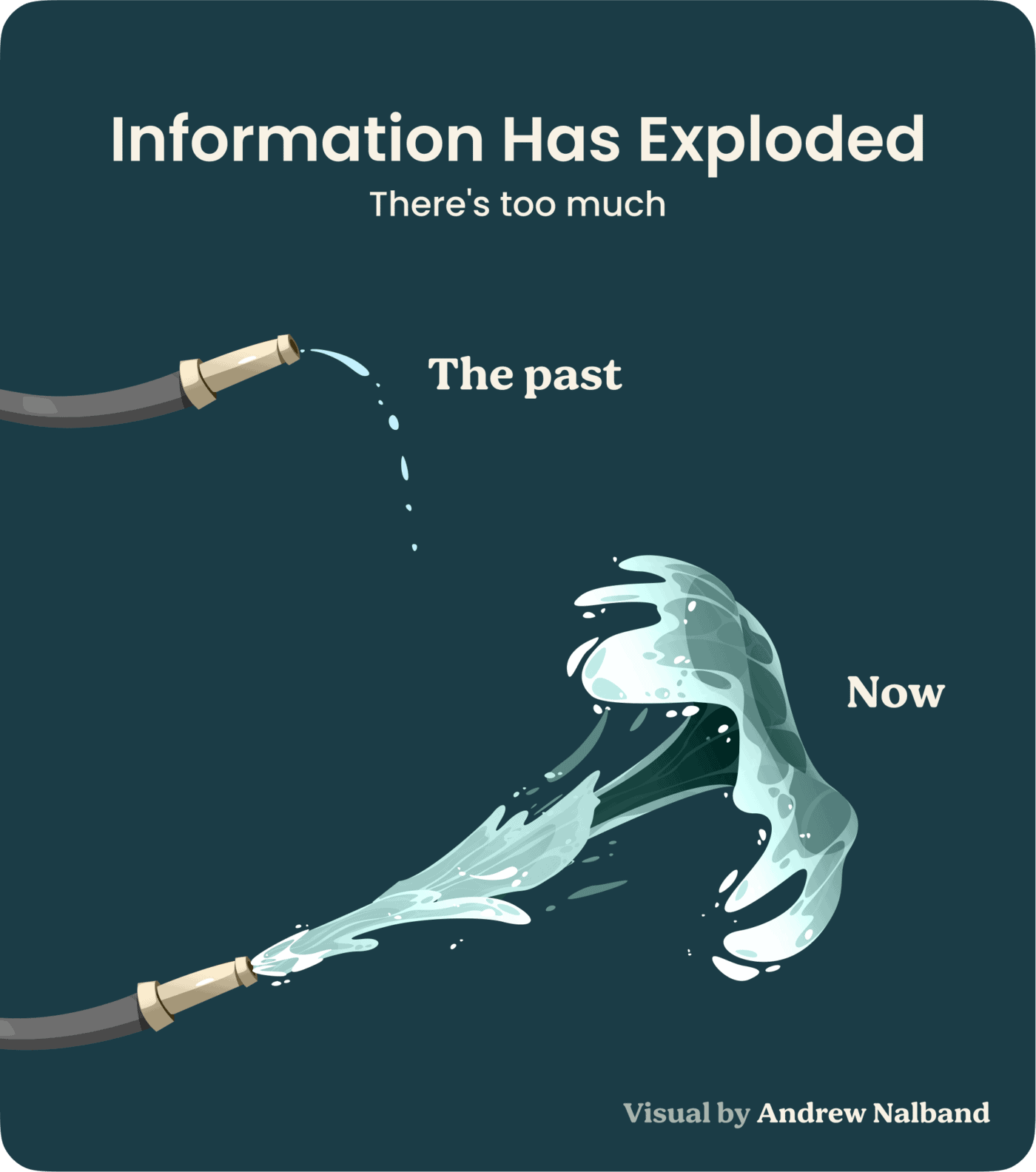
All of these kinds of content have value, but trying to remember all of it is overwhelming and impractical. By consolidating ideas from these sources, you’ll develop a valuable body of work to advance your projects and goals. You’ll have an ongoing record of personal discoveries, lessons learned, and actionable insights for any situation.
We are already doing most of the work required to consume this content. We spend a significant portion of our careers creating snippets of text, outlines, photos, videos, sketches, diagrams, webpages, notes, or documents. Yet, without a little extra care to preserve these valuable resources, our precious knowledge remains siloed and scattered across dozens of different locations. We fail to build a collection of knowledge that both appreciates in value and can be reused again and again.
By offloading our thinking onto a Second brain, we free our biological brain to imagine, create, and simply be present. We can move through life confident that we will remember everything that matters, instead of floundering through our days struggling to keep track of every detail.
Your Second Brain will serve as an extension of your mind, not only protecting you from the ravages of forgetfulness but also amplifying your efforts as you take on creative challenges.
The Building a Second Brain Methodology will teach you how to:
- Reduce stress and “information overload” by curating and managing your personal information stream
- Create a digital environment that promotes clarity and peace of mind
- Unlock the full value of the wealth of learning resources all around you, such as online courses, webinars, books, articles, forums, and podcasts
- Find anything you’ve learned, touched, or thought about in the past within seconds
- Spend less time looking for things and more time doing the best, most creative work you are capable of
- Cultivate a collection of valuable knowledge and insights over time without having to follow rigid, time-consuming rules
- Consistently move your projects and goals to completion by organizing and accessing your knowledge in a results-oriented way
- Turn work “off” and relax, knowing you have a trusted system keeping track of all the details
So, how do you build your Second Brain?
To guide you in the process of creating your own Second Brain, I’ve developed a simple four-step method called CODE, which stands for Capture, Organize, Distill, and Express.
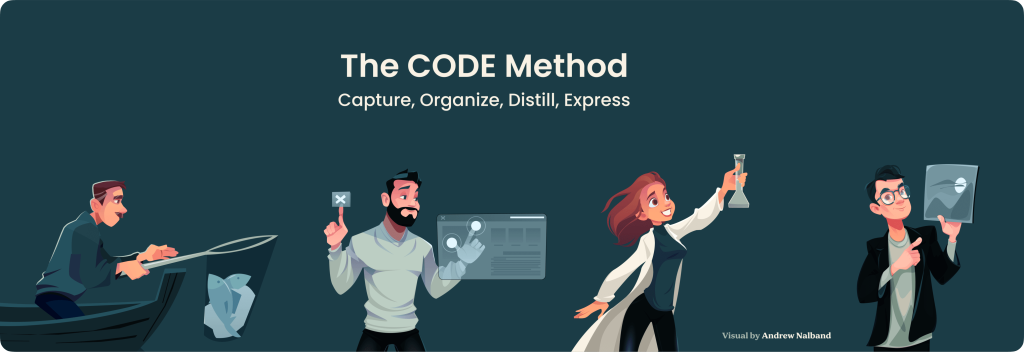
These are the steps not only to build your Second Brain but also to work with it going forward.
CODE is a proven process for consistently turning the information you consume into creative output and concrete results. And it’s based on timeless principles that humans throughout history have used to create anything imaginable.
The four steps of CODE are flexible and agnostic for any profession, role, or career and for whatever notetaking methods and platforms you prefer. You’re probably already doing them already in some form, whether you realize it or not.
Let me introduce you to each step, starting with Capture.
Capture only the most important information
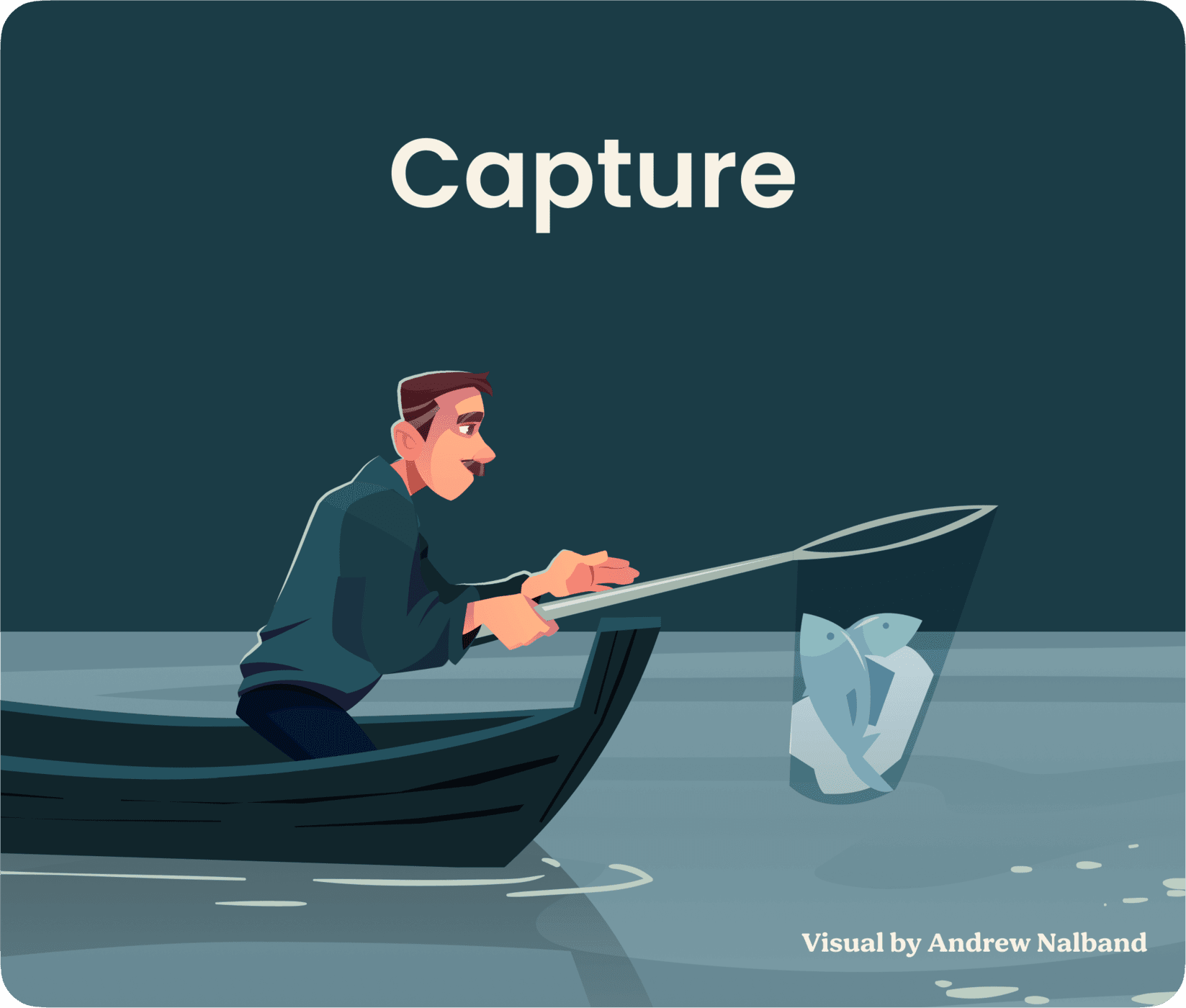
The first step in building a Second Brain is “capturing” the ideas and insights you think are worth saving. Ask yourself:
- What are the recurring themes and questions that I always seem to return to in my work and life?
- What insightful, high-value, impactful information do I already have access to that could be valuable?
- Which knowledge do I want to interconnect, mix and match, and periodically resurface to stimulate future thinking on these subjects?
Most of the time we tend to capture information haphazardly – we email ourselves a quick note, brainstorm some ideas in a Word document, or take notes on books we read – but then don’t do anything with it.
We are already consuming or producing this information, we just need to keep it in a single, centralized place, such as a digital notetaking app like Evernote, Microsoft OneNote, Notion, Apple Notes, Obsidian or others. These apps facilitate capturing small “snippets” of text as well as hyperlinks, images, webpages, screenshots, PDFs, and other attachments, all of which are saved permanently and synced across all your devices.
By keeping a diverse collection of information in one centralized place, it is now free to intermix and intermingle, helping us see unexpected connections and patterns in our thinking. This also gives us one place to look when we need creative raw material, supporting research, or a shot of inspiration.
The following three guidelines will help you capture only the most relevant and useful information in your Second Brain.
Think like a curator
The second we pick up our mobile device or sit down in front of our computer, we become immersed in the flow of juicy information we are presented with.
Much of this information is useful and interesting – articles written by experts that could make us more productive, tips on exercise and nutrition, or fascinating stories from around the world. But unless we make conscious, strategic decisions about what we consume, we’ll always be at the mercy of what others want us to see.
Too often, we just passively react to the information that’s been shoved in front of us by other people and algorithms.
How do you escape this reactivity loop?
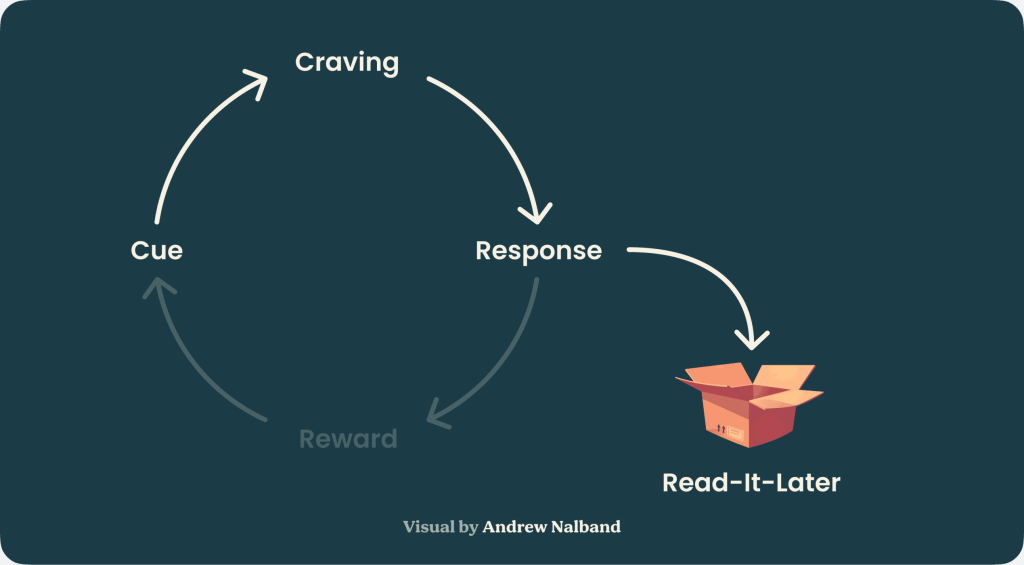
Instead of immediately consuming what’s in front of you, save it so you can revisit it later (at a time that’s reserved for consumption).
Read-later apps such as Readwise’s Reader, Instapaper, or Pocket are designed for this particular purpose. As you begin to collect content, you’ll be able to choose which sources to consume in a deliberate way.
Keep only what resonates

The word “capturing” often brings to mind an analytical way of thinking. But analysis is time-consuming and tiring. In deciding which passages, images, theories, or quotes to keep, don’t make it a highly intellectual, analytical decision.
Instead, your rule of thumb should be to save anything that “resonates” with you on an intuitive level.
This is often because it connects to something you care about, wonder about, or find inherently intriguing. By training ourselves to notice when something resonates with us at a deeper level, we improve not only our ability to see opportunities, but also our understanding of ourselves and how we work.
Utilize capture tools
When you dive into the world of digital notetaking, you’ll soon come across an array of specialized “capture tools,” designed to make capturing content in digital form easy and even fun.
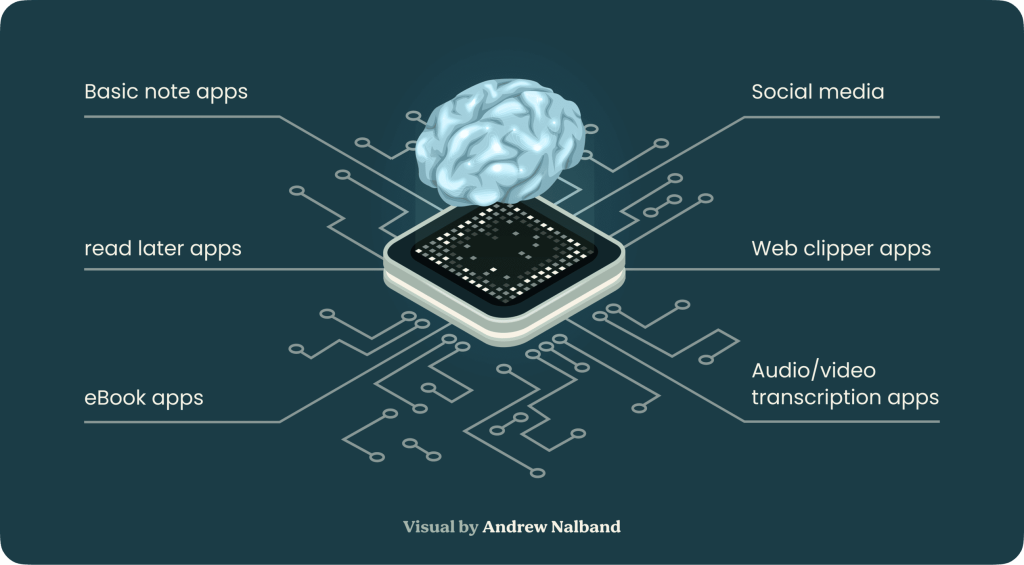
The most common options include:
- Ebook apps: Export your highlights or annotations from the books you’ve read
- Read later apps: Save content you find online for later consumption and export your highlights into your notetaking app
- Basic notes apps: Capture snippets of text on the fly with these preinstalled apps on your mobile device
- Social media apps: “Favorite” content and export it to your notetaking app
- Audio/voice transcription apps: Create text transcripts from spoken words
- Web clipper apps: Save parts of web pages (often included as a built-in feature of notetaking apps)
While some of these tools are free, others charge a small fee. Some work silently in the background (for example, automatically syncing your ebook highlights with your notes app), and others require some manual effort (such as taking photos of paper notebooks to save them digitally).
In any case, the act of capturing takes seconds—to hit share, export, or save—and voilà, you’ve preserved the best parts of whatever you’re consuming in your Second Brain.
Since the software landscape is constantly changing, we’ve created a Resource Guide with updated recommendations of the best capture tools, both free and paid, and for a variety of devices and operating systems.
Organize for actionability

As you begin to collect notes on ideas that resonate with you, you will eventually feel the need to organize them.
It can be tempting to try to create a perfect hierarchy of folders from the get-go, with the aim of capturing every possible note you might ever come across. However, this approach is not only time-consuming, but it also diverts your attention from what interests you now, requiring too much effort.
Most people tend to organize information by subject, similar to the Dewey decimal system used in libraries. For example, books might be classified under broad subject categories such as “Architecture,” “Business,” “History,” or “Geology.”
When it comes to digital notes, simpler and more flexible organization methods are preferable. Our priorities and goals can change quickly, so we should avoid organizing methods that are overly rigid and prescriptive.
The best way to organize your notes is to focus on your active projects. When you encounter new information, think about how it can help you move forward something you’re currently working on.
Surprisingly, focussing on taking action, will also help you combat information overwhelm. There are relatively few things that are actionable and relevant at any given time, which makes it easier to ignore everything else.
Organizing for action can provide a great sense of clarity because you know that everything you’re keeping has a purpose and aligns with your goals and priorities. Instead of being a hindrance to your productivity, organizing becomes a tool to enhance it.
The following three guidelines will help you organize the information in your Second Brain effectively.
Adopt the PARA Method
After more than a decade of personal experimentation, teaching thousands of students, and coaching world-class professionals, I’ve developed a way to organize information by actionability.
It’s called PARA – a simple, comprehensive, yet extremely flexible system for organizing any type of digital information across any platform.
Rest assured, adopting this approach will not only bring a sense of order to your life but also equip you with valuable tools to manage the flow of information and accomplish any goal you set for yourself.
The PARA Method is grounded in a fundamental observation: that all the information in your life can be categorized into only four categories.
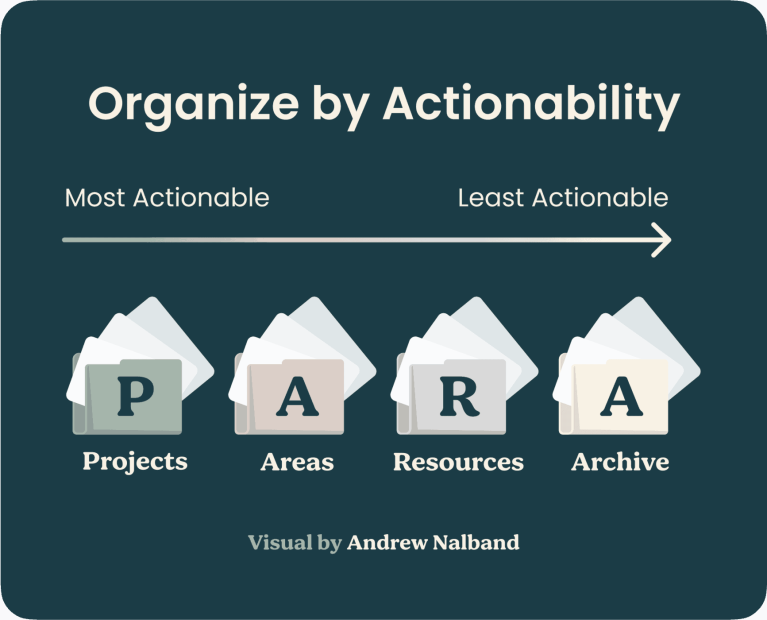
- Projects: short-term efforts (in your work or personal life) that you take on with a certain goal in mind
- Areas: Long-term responsibilities you want to manage over time
- Resources: Topics or interests that may be useful in the future
- Archive: Inactive items from the other 3 categories
It might be hard to accept that a sophisticated and contemporary human existence like yours can be reduced to just four categories. It may seem like you have more to manage than could possibly fit into such a basic system.
However, that is precisely the objective. If your organizational system is as intricate as your life, then the effort required to maintain it will deprive you of the time and energy necessary to actually live your life.
The system you use to manage information must be so effortless that it liberates your focus rather than constraining it. Your system must provide you with time, not consume it.
Start with a clean slate
I found that the number one roadblock to implementing PARA or any other organizational system is that most people think they have to sort ALL their existing notes and files into it.
I couldn’t think of a more boring, demotivating task. It would take you hours if not days!
And the result? You’ll probably feel just as overwhelmed by the sheer volume of information you now have to manage as before.
Here’s what I recommend instead (it will take you less than 60 seconds to do):
Move all existing files to a folder titled Archive with today’s date.
Consider this folder a “time capsule” that preserves everything you had going on until this precise moment. Now, it separates what was saved prior to today’s date from what you’ll save from this point on.
That’s it! Your digital workspace is now completely clean so you can start over.
The best thing is that you’re not deleting anything. Whenever you need a file, you can always pull it out of your Archive folder. But my guess is that you won’t need as many old notes as you think you do.
Ask three questions

Now that you’re starting from a clean slate, how do you “process” any new items into the appropriate PARA folders?
Ask yourself the following three questions to consider in which project, area, or resource a given piece of information will be most relevant and useful.
- What project would this be useful?
- If none: Which area will this be useful for?
- If none: Which resource does this belong to?
- If none, it’s probably best to archive this information or not save it at all.
With some practice, this decision will only take you a few seconds.
I prefer to do this “filing” in one batch about once a week. I pull up my “Inbox” – a separate folder as a temporary holding area where new items accumulate until I have time to put them in their proper place – and process 10-20 items in just a few minutes.
Don’t overthink where you’re going to put a certain piece of information within PARA. Remember that you can almost certainly find anything again using a simple search.
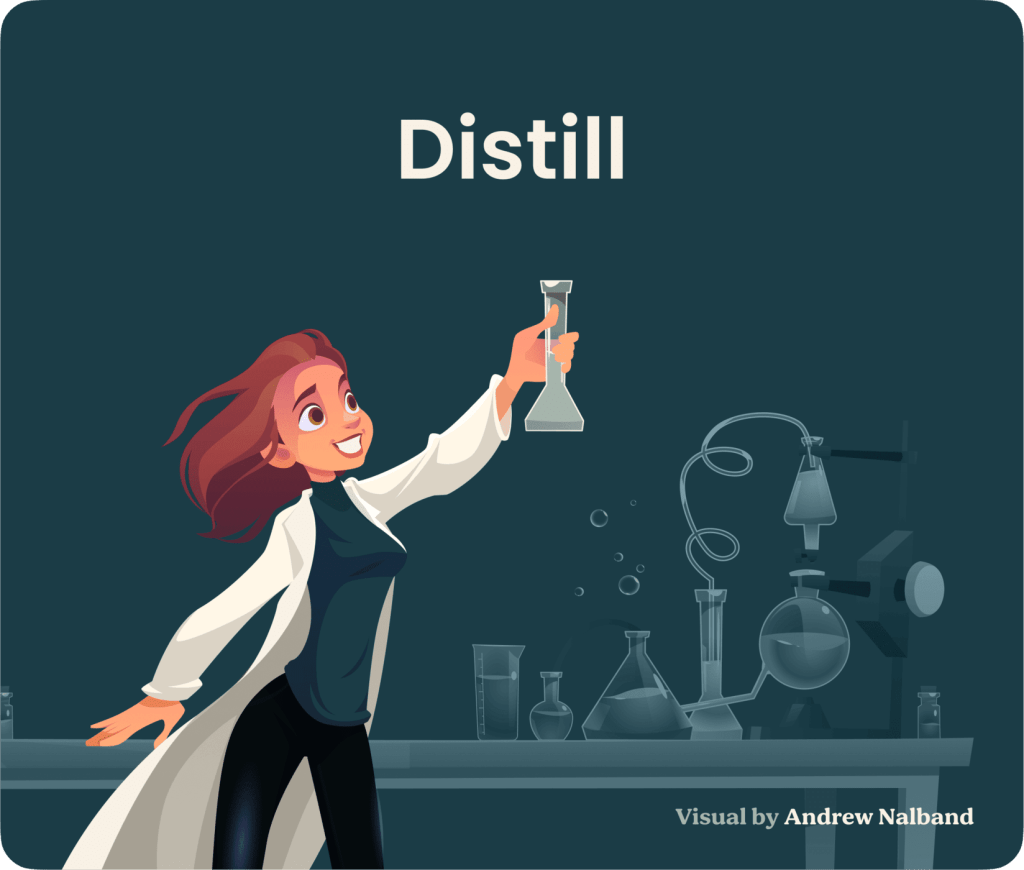
Once you start collecting valuable knowledge in a centralized place, you’ll naturally start to notice patterns and connections. An article you read on gardening will give you an insight into online marketing. An offhand comment by a client will give you the idea of creating a webpage with client testimonials. A business card you saved from a conference will remind you to follow up and propose a collaboration.
You can greatly facilitate and speed up this process by distilling your notes into actionable, bite-sized summaries.
It would be near impossible to review your 10 pages of notes on a book you read last year in the midst of a chaotic workday, for example. But if you had just the main points of that book in a 3-point summary, you could quickly remind yourself of what it contains and potentially apply it to something you’re working on.
The following three guidelines will help you summarize and distill your notes into actionable, useful tools for execution.
Design notes for your future self
A powerful mindset for interacting with our notes is to “design notes with your future self in mind.”
Think of notetaking as time travel. You’re sending packets of knowledge through time to your future self.
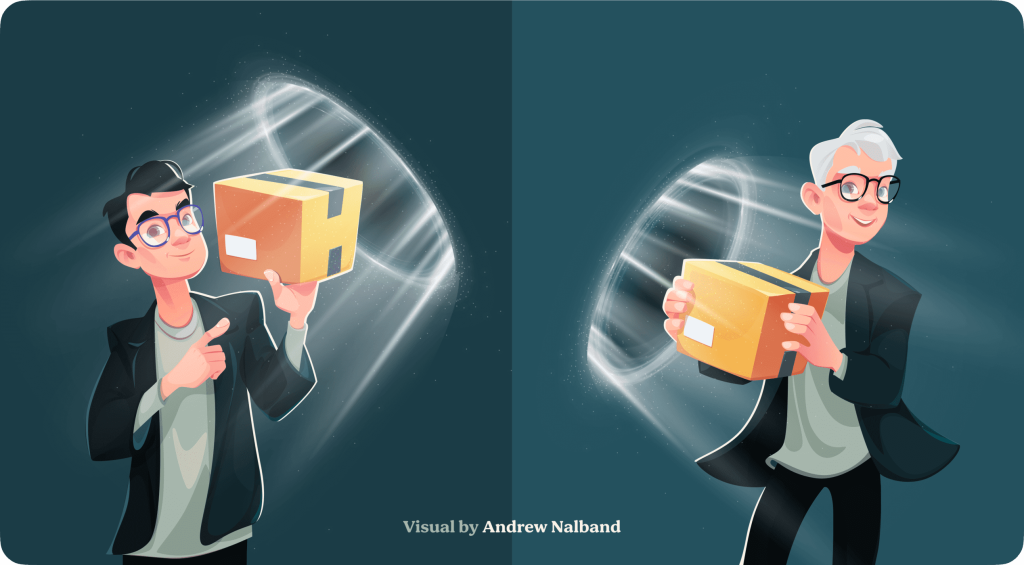
So the challenge is: “How do I make what I’m consuming right now easily discoverable for my future self?”
Every time you create a note or make an edit, you can make it just a little easier to find and make use of next time.
This can include:
- Defining key terms in case we forget what they mean
- Inserting placeholders when we leave off so we know where to pick back up
- Adding links to related websites, files, or emails that we’re likely to forget over time
By constantly saving packets of knowledge in a format that our future self can easily consume, we follow a “pay it forward” strategy that we get to benefit from in the future!
Summarize progressively, at different levels of detail
A common problem with notes is that they are too long and dense. You can’t afford the time it would take to review and remind yourself of everything they contain. Executive summaries can help, but often it is a challenge to identify what exactly the main point is in the first place.
Progressive Summarization is a technique that relies on summarizing a note in multiple stages over time.
You save only the best excerpts from whatever you’re reading, and then create a summary of those excerpts, and then a summary of that summary, distilling the essence of the content at each stage. These “layers” are like a digital map that can be zoomed in or out to any level of detail you need.
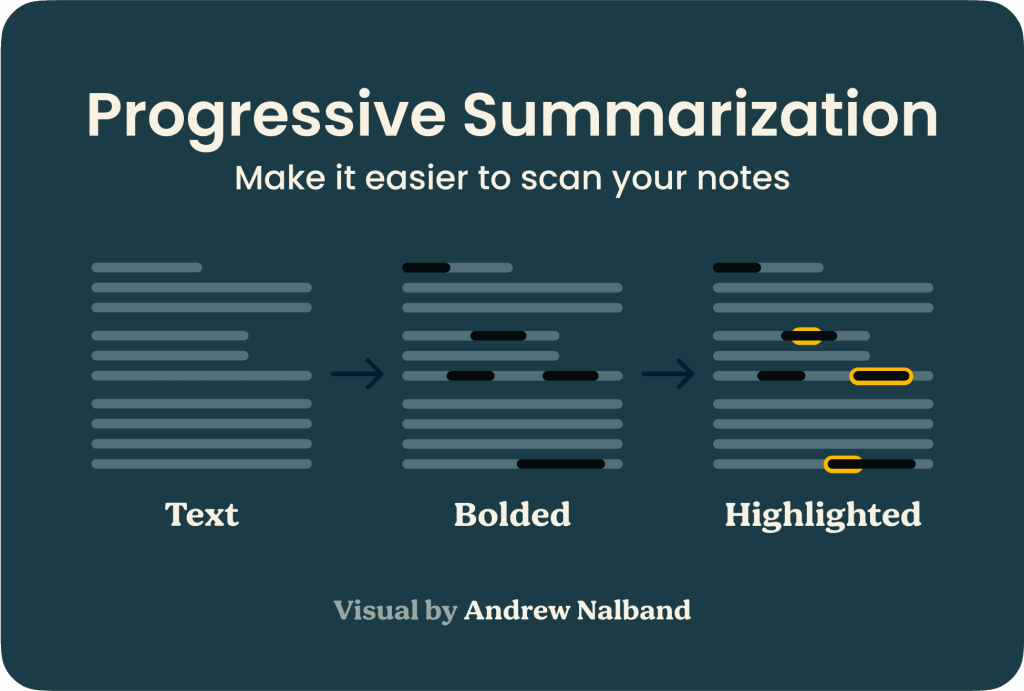
Progressive Summarization allows you to read the note in different ways for different purposes: in depth if you want to glean every detail, or at a high level if you just need the main takeaway. This allows you to review a note’s contents in seconds to decide if it’s useful for the task at hand.
Distill opportunistically, a little bit at a time
It can be tempting to spend a lot of time creating highly structured, perfect notes. The problem is, you often have no idea which sources will end up being valuable until much later.
Instead of investing a lot of effort upfront, distill your notes opportunistically, in small bits over time
Your rule of thumb should be: add value to a note every time you touch it. This could include adding an informative title the first time you come across a note, highlighting the most important points the next time you see it, and adding a link to a related note sometime later.
By spreading out the heavy work of distilling your notes over time, you not only save time and effort but ensure that the most frequently used (and thus most valuable) notes surface organically, like a ski slope where the most popular routes naturally end up with deeper grooves.
Express your unique ideas and experiences
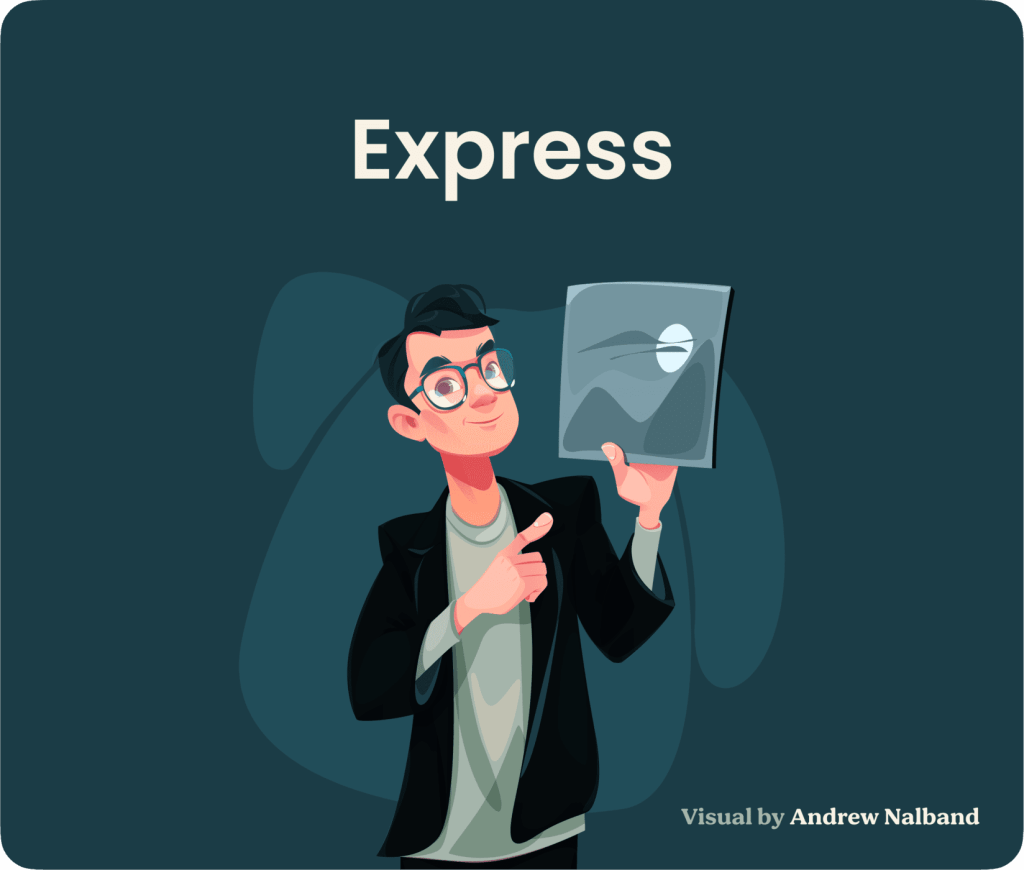
All of this capturing, organizing, and distilling has one ultimate purpose: creating tangible results in the real world. Whether we want to lose weight, get a promotion at work, start a side business, or contribute to a cause we believe in, the true purpose of learning is to turn our knowledge into effective action.
With a substantial reserve of supporting material in your Second Brain, you never need to sit down to an empty page and try to “think of something smart.” All creativity stands on the shoulders of giants, and you have the benefit of already having the best ideas of those giants documented in your notes!
What should you create?
It depends on your skills, interests, and personality. If you are analytical, you could draw on a group of articles you’ve read about Big Data to write a blog post summarizing where you think machine learning is headed next. If you like to perform, you could borrow ideas from your notes on YouTube cooking videos you’ve enjoyed to make one of your own. If you are campaigning for investment in your local park, you could distill the minutes from past city council meetings into a speaking agenda for your public comments at the next one.
With a Second Brain at your disposal, you always have something to inspire you, remind you, support you, or guide you as you engage in the projects and interests that are important to you. You can draw on the sum total of your life experience and learning, not just whatever you can think of in the moment.
The following three guidelines will help you create more, better, and more meaningful creative output for whatever purpose you decide is important.
Don’t just consume information passively – put it to use
A common challenge for people who love to learn is that they constantly force-feed themselves more and more information, but never actually put it to use.
The goals and the experiences that would enrich their lives get endlessly postponed, waiting for the “right” bit of knowledge they supposedly need before getting started.
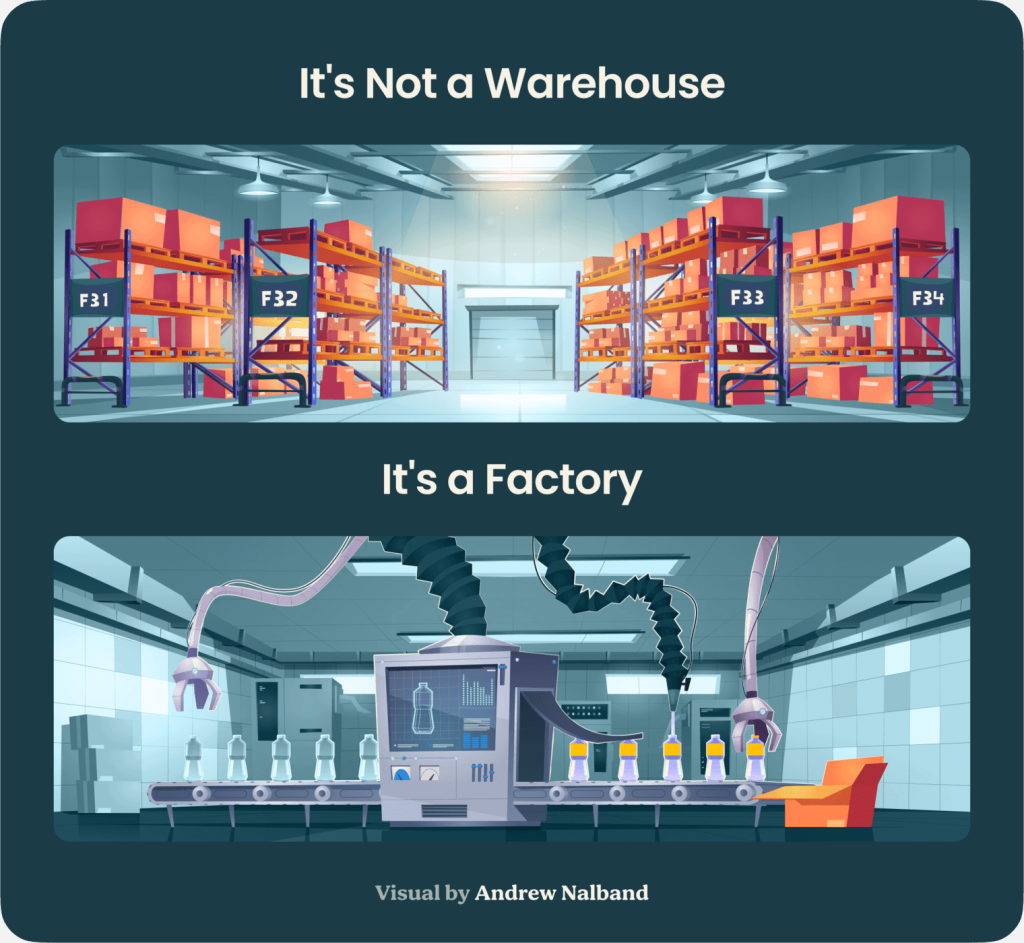
But information only becomes knowledge – something personal, embodied, grounded – when we put it to use. That’s why we should shift as much of our effort as possible from consuming information, to creating new things. The things we create – whether they are writing pieces, websites, photographs, videos, or live performances – embody and express the knowledge we’ve gained from personal experience.
Think of your Second Brain not as a warehouse where you simply store your most valuable ideas, but as a factory that helps you turn those ideas into concrete results.
We all need to be part of bringing to life something good, true, or beautiful. Creating things is not only deeply fulfilling, it can also bring us unexpected opportunities, introduce us to new friends or collaborators, and have a positive impact on others – by inspiring them, entertaining them, or informing them.
Create smaller, reusable units of work
Once you start to curate a collection of valuable knowledge in external form, a very different way of working becomes not only possible, but necessary.
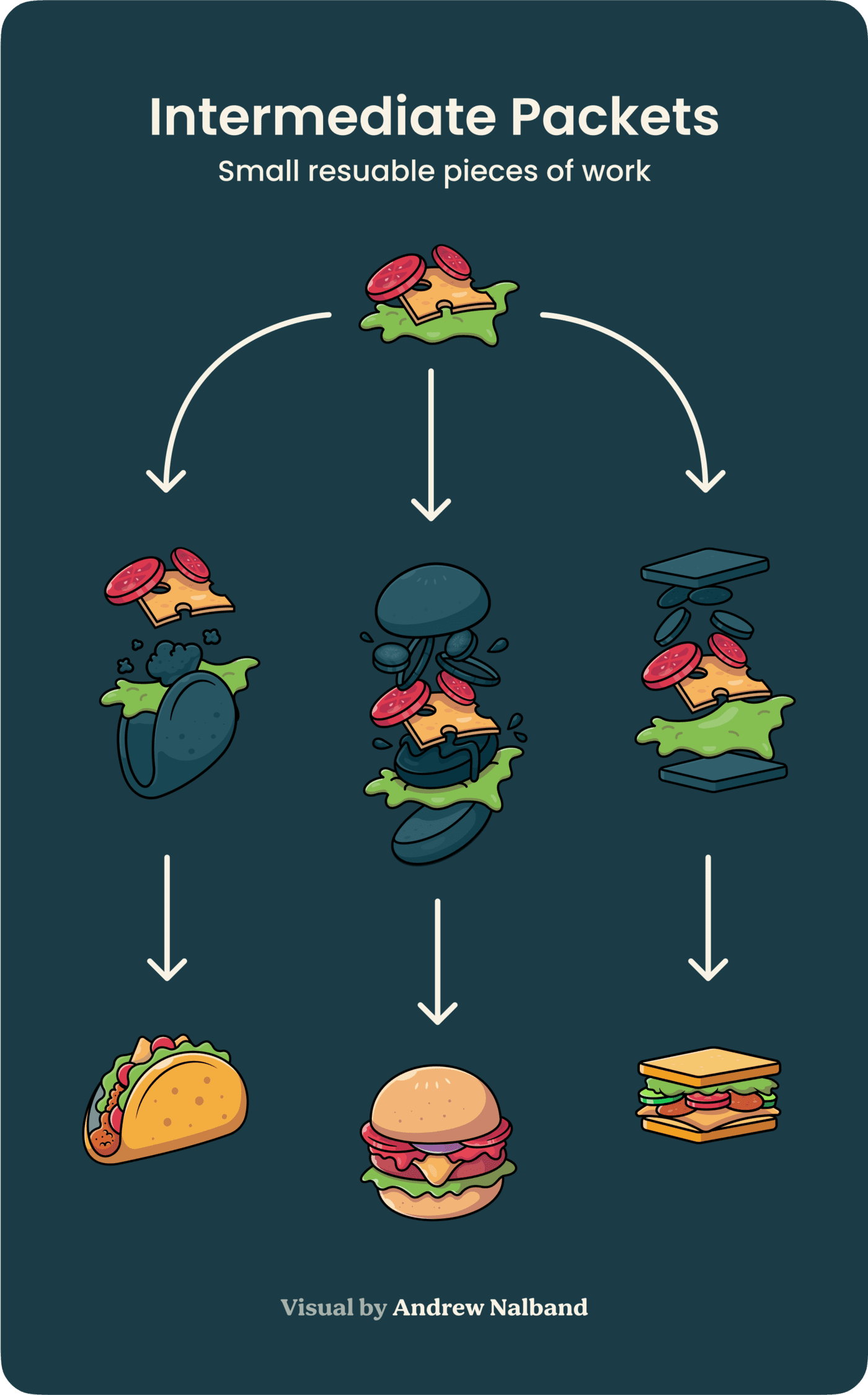
You will begin to think of your projects as made up of discrete parts.
I call them Intermediate Packets, which can include any kind of content we’ve already mentioned: a set of notes from a team meeting, a list of relevant research findings, a brainstorm with collaborators, a slide deck analyzing the market, or a list of action items from a conference call, for example.
Instead of trying to sit down and move the entire project forward all at once, which is like trying to roll a giant boulder uphill, a more effective approach is to end each work session – whether it is 15 minutes or 3 hours – by completing just one Intermediate Packet.
This allows you to work in smaller increments, making use of any available span of time, while getting lots of feedback and taking frequent breaks.
Not only does this result in higher quality output, it fuels the motivation and the inspiration that we need to do our best work. These Intermediate Packets can then be saved to your Second Brain, and re-used the next time you have a similar need.
Share your work with the world
There are many benefits all along the process of building a Second Brain: less stress, better focus, more insights, and enhanced productivity. But the real payoff comes at the end, when you create something out of the knowledge you’ve collected and share it with the world.
It can be tempting to wait until everything is “ready,” until you have all the information you think you need, and all the sources have been double-checked and reviewed. But as you continually curate and save pieces of content, review and summarize them, create a series of Intermediate Packets, and then recycle them back into your Second Brain, you’ll start to realize that there is no such thing as a finished product.
Everything is in flux, everything is a work in progress, and everything you put out there has an implicit “version 1.0” attached to it.
This can be tremendously empowering – since nothing is ever final, there is no need to wait to get started. You can publish a simple website now, and slowly add additional pages as you have time. You can publish a draft blog post now, and make revisions later after you’ve received feedback. You could even self-publish an ebook on the Kindle store, and any future updates to the manuscript will be wirelessly synced to everyone who purchased the book.
By consistently sharing your work with others – whether that is your family, friends, colleagues, or externally on social media – all sorts of benefits will start to materialize.
You’ll connect with new collaborators who you never would have imagined would find your work compelling. You’ll attract clients or customers, in some cases even when you weren’t seeking them. Others will reflect back to you their reactions and comments and appreciation (and occasionally criticism). You’ll find that you are part of a community that shares your interests and values.
Accomplishing anything meaningful or important requires working with others, and the incredible power of the internet now allows us to find each other no matter how obscure or strange our interests.
The power of having a Second Brain
Each note in your Second Brain is a record of something you’ve experienced in your life – whether that is from reading a book, having an interesting conversation, or completing a project at work.
With all your most valuable ideas at your fingertips at all times, you never need to struggle and strain to remember everything you’ve learned.
As your Second Brain gains momentum over weeks and months, you will start to become different. You will no longer think about things in isolation, but as part of a network of ideas in which everything affects everything else. You’ll realize that something you learned at work about effective communication also applies to your family vacation debate. A random fact you read in an airplane magazine will somehow end up being useful in a blog post you’re writing. A lesson from Ancient Greek history you picked up from a podcast on your morning commute will help you deal with a crisis at the office.
You will start to think in terms of the systems and principles that you’ve gleaned through your summarizing and reviewing, and see them everywhere. Your mind will start to work differently, learning to depend on this external tool to draw on resources, references, and research far beyond what it can remember on its own. You will start to conceive of “your work” as an integrated whole that you can actually point to, shape, and navigate in a direction of your choosing. You’ll be more objective and unattached, because if any single idea doesn’t work out, you know you have a huge trove of others ready to go.
Over time, you will start to recognize that everything you are learning and experiencing makes sense. You can see, mapped in the notes you are cultivating, the underlying structure of your life. Why you do things, what you really want, what’s really important and what isn’t.
Your Second Brain becomes like a mirror, reflecting back to you who you think you are, who you want to be, and who you could become. Because you know how to capture and make use of anything, every experience you have becomes an opportunity to learn and grow.
As this self-understanding dawns, you will look around at the notes you’ve collected, and you will realize that you already have everything you need to get started. You will start combining the ideas together, forming new perspectives, new theories, and new strategies. Ideas about society, about art, about psychology, about spirituality, about technology will start intermixing and spawning ideas you’ve never consciously considered. You’ll be shocked, in fact, at the elegance and power of what pops out of your notes.
This epiphany won’t just exist in your head. People can tell. They’ll start to notice that you can draw on an unusually large body of knowledge at a moment’s notice. They will admire your amazing memory, but what they don’t know is that you never try to remember anything. They’ll admire your incredible self-discipline and dedication at developing ideas over time, not knowing that you’ve created a system in which insights and connections emerge organically. They’ll be impressed by your ability to produce so much creative output, but in reality, you never lock yourself in a room to “crank out” some work. You just let your projects simmer until they’re ready.
Building a Second Brain is an integrated set of behaviors for turning incoming information into completed creative projects.
Instead of endlessly optimizing yourself, trying to become a productivity machine that never deviates from the plan, it has you optimize an external system that is more reliable than you will ever be. This frees you to imagine, to wonder, to wander toward whatever makes you come alive here and now in the moment.
Your next steps
Here are three ways to start building your Second Brain:
- Get the BASB Book: Learn the proven method to organize your digital life and unlock your creative potential.
- Join BASB Foundation: Build your Second Brain on your own time and at your own pace with our self-paced course.
- Join the next BASB live cohort: Build your fully functional Second Brain with the momentum, accountability, and support of our team and like-minded Second Brainers.
The beautiful visuals in this blog post were created by Andrew Nalband, founder of Thunk Notes.
- POSTED IN: Building a Second Brain, Education, Note-taking, Organizing, Productivity, Workflow
